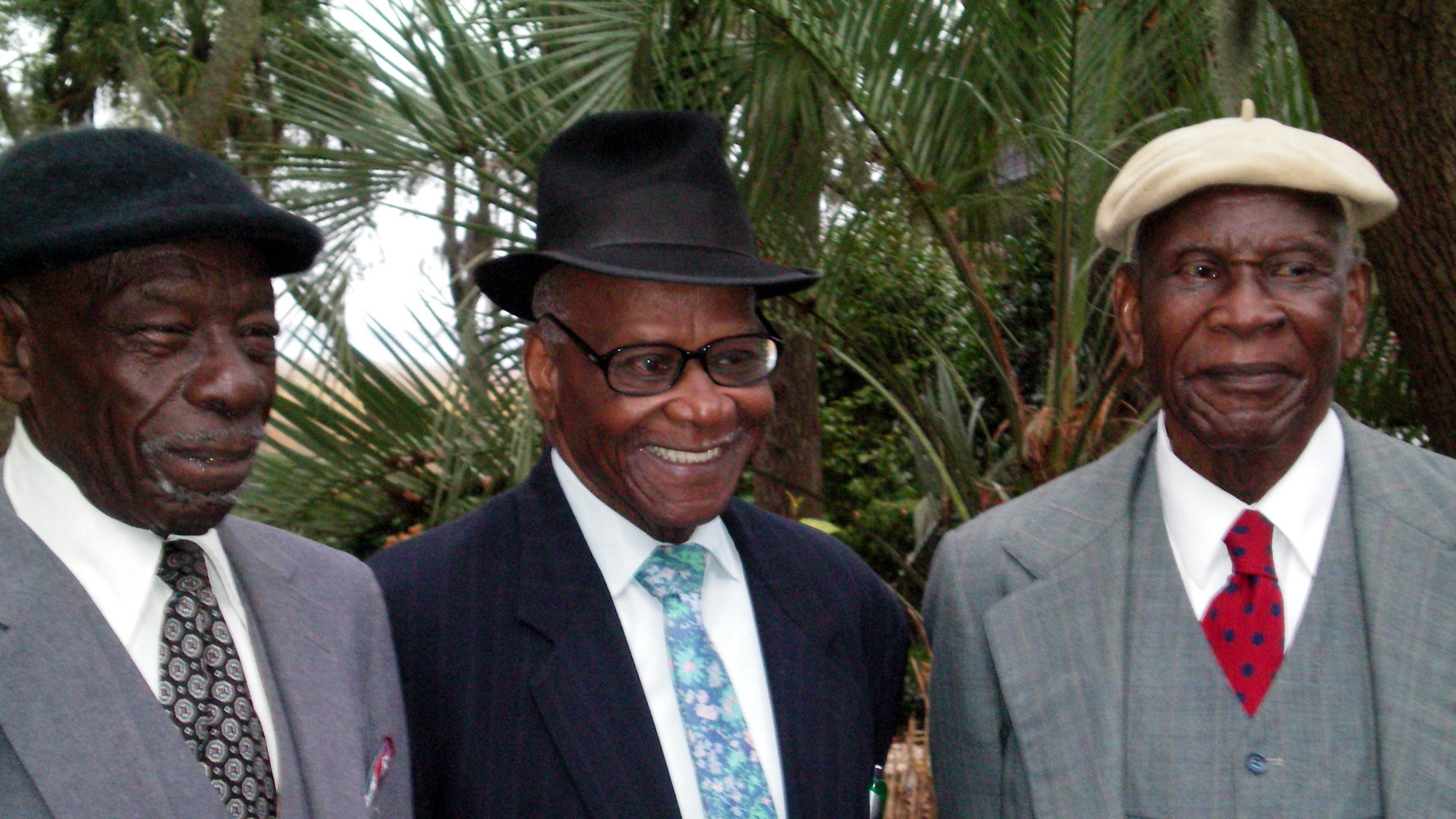Robinson brothers Nathan “Willie”, Andrew “Bullet”, and Arthur “Sonny” in December 2007 at the Rededication Ceremony for the Cotton Dike Cemetery, where their ancestors are buried.
This week’s theme is UNCERTAINTY. Heaven knows stories of our past are full of uncertainties. And in many cases, we will never get the definitive answer to our questions. Take, for example, who is buried in the Cotton Dike Cemetery? This story begins in 2004 with an interview with two brothers, then wanders through monuments, ground-penetrating radar, a rededication ceremony, and the British territory of Saint Helena Island. It ends with the recent graveside service of Andrew Robinson. We are grateful to Andrew, his brothers, and his nephew for bringing a measure of certainty to our Cotton Dike cemetery.
Andrew “Bullet” Robinson (1923 – 2020)
The Dataw Historic Foundation interviewed several people about 20 years ago who had ties to the earliest days of Dataw Island’s development by Alcoa. In 2004, Andrew “Bullet” Robinson (1923 – 2020) and his brother Deacon Nathan “Willie” Robinson (1913 – 2018) were interviewed by Cathy Crocker and others. I suspect this interview may have been part of the impetus for the ground-penetrating-radar survey of several locations, including Cotton Dike Cemetery, which occurred the next year. To commemorate Andrew’s recent passing, today I focus on his role with our Cotton Dike Cemetery.
These brothers were born on St. Helena Island, or maybe Dataw Island. Andrew was the twelfth of thirteen children born to Nathan Robinson (1886 – 1979) and his wife, Harriet (1888 – 1961). What is certain is Nathan Robinson and the family lived on Dataw from 1928 to 1933, when he was hired by Kate Gleason to be the caretaker of her recently purchased island. They probably lived here before that, since one of their infant sons, Freddy, was buried here in 1922 [Interview 2004 and cemetery list 2007].
Andrew was a graduate of the Penn Normal Industrial and Agriculture School in Penn Center on St. Helena. He moved north to New York City and remained there for the rest of his life. Andrew was a graduate of New York State University, a longshoreman, a carpenter, an artist, a licensed real estate agent, and a small businessman.
In 2007, Andrew and his brother Deacon Willie showed up at Dataw Island’s gate house and said they needed to talk to someone about erecting a monument to their ancestors!
Lots of calls ensued to identify who they should talk to. Fortunately for us, John Colgan of the DHF met with the brothers to discuss their request, but there was a real challenge. John spoke Bronx English and Deacon Willie spoke Gullah. Of course, Andrew spoke both since by this time he had been in New York City for over fifty years. John asked his neighbor Gloria Cartwright to attend this first meeting. Gloria lived a few houses away from John on Longfield Drive. She was born and raised on St. Helena Island and spoke Gullah fluently. This first meeting was very successful in spite of the communication challenges. All agreed that putting up several interpretive signs in the cemetery, rather than a monument, would be suitable.
Andrew came back a second time and met John at his house to go over a list of names of those buried in Cotton Dike Cemetery. Andrew’s nephew Nathanial Robinson had compiled the list from old Bibles and family conversations.
From the beginning of Dataw’s development, the cemetery near the end of Cotton Dike Road was known to be a slave cemetery. That is not quite right. While slaves were buried here, so were freedmen (and women). The last burial was in 1967. (You can learn more about this cemetery from John’s presentation The Tale of Two Cemeteries.) Thanks to Andrew, his brothers, his nephew Nathanial Robinson, and the DHF and DIOA team in 2007, this cemetery is no longer filled with unknown souls.
Cotton Dike Cemetery (1785 – 1967)
Peter Pearks, our sign maestro then and now, took care of fabricating and installing the two signs agreed to. The Dataw Historic Foundation paid for the signs, as they have always done for all signs. Today there are four, as shown in the picture below, at Cotton Dike Cemetery. The impetus for the additional signs came from information provided by Mike McMahon, who currently lives just to the right of the Cotton Dike Cemetery. If you haven’t visited this cemetery near the end of Cotton Dike Road, here is the text of the interpretive sign written by John Colgan and Perry Gesell in the summer of 2007:
“Initially begun as a final resting place for field slaves in antebellum times, this cemetery served generations of Dataw Island residents through the Reconstruction period and well beyond. The last recorded burial occurred in 1967.
This historic and sacred burial ground contains the remains of African slaves, free African-Americans, and their descendants who contributed greatly to the economic, social and religious life of Datha (Dataw) Island and the greater Beaufort area.
Cotton Dike Cemetery is a tangible reminder of the dependence of many large farmers on slave labor from the mid-1700’s to 1864. It is a reflection of the many traditions of the African-American slave population. Death rituals and shoreline burial practices formed an important part of those traditions and death itself carried great significance among slaves throughout the South.
The Cotton Dike Cemetery was considerably larger than what you see before you today. Over the years, water erosion has reduced the cemetery to its present size. A survey completed in 2006 indicated that there are 38+ grave sites still intact.”
Although we are eternally grateful to Andrew Robinson and his research assistant (nephew Nathanial) for giving us the names they knew of, it still is only about half of those buried here.
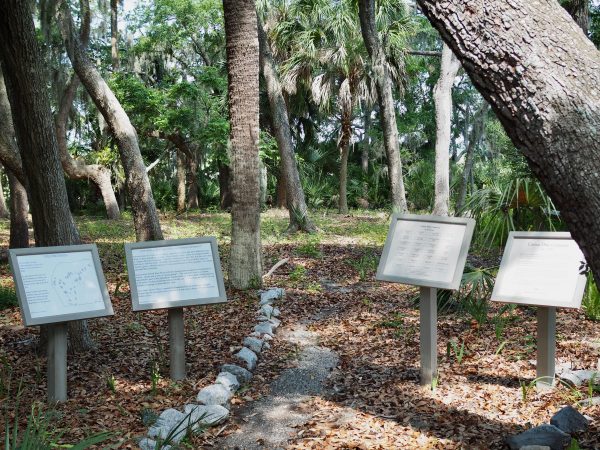
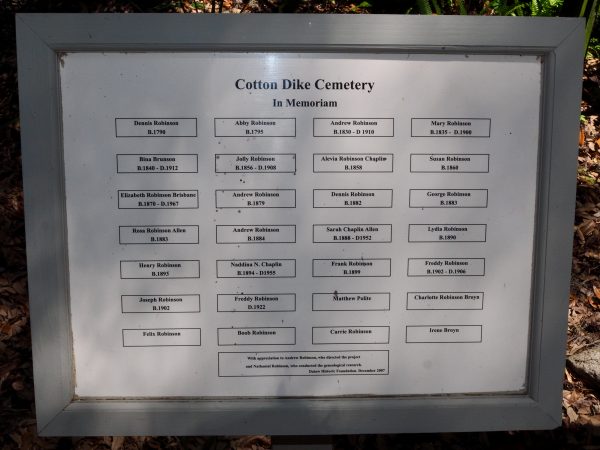
Rededication Ceremony (2007)
John Colgan worked with the DHF, the previous General Manager, and their staffs to get the interpretive signs made and organized a ceremony for the Rededication of the Cotton Dike Cemetery. That event was held in a winter drizzle on December 29, 2007. It was quite an event per John, “…some 50 or so Robinson kinfolk showed up! Complete with their minister, their family historian, and a singer! We set up chairs for the crowd and Lori Murdaugh and the previous GM attended; the ceremony lasted about 45 minutes. Afterwards, some of the mothers brought their children to view the plaques. It was the first time that many of them had ever known where their great grandfathers and mothers were buried! A very touching moment!!
A very big and tall man came up to me and told me that he worked for one of the moving companies. He said he had been on and off Dataw Island for years and never knew where his antecedents were buried until then! It truly was a special moment for him and I was so glad that I had a part to play in this.”
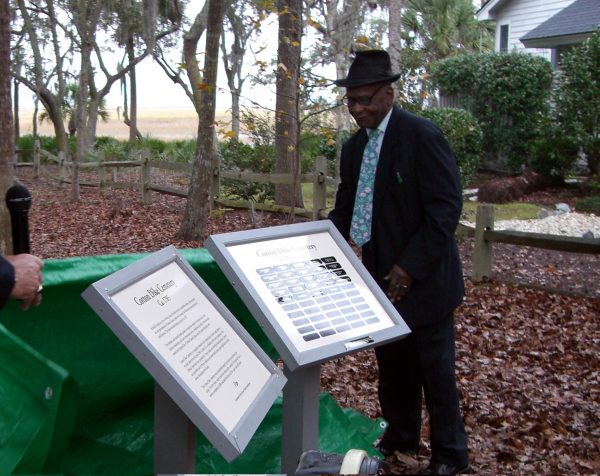
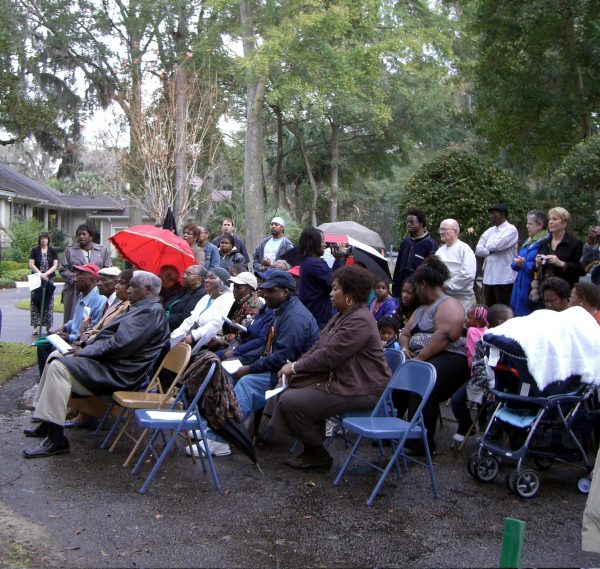
Annina Van Neel Hayes (2018)
In November of 2018, Victoria Smalls, a well respected local African American advocate, brought a small group to Dataw Island to ‘see the Cotton Dike Cemetery’. The visit was so much more than that. With her was Peggy King Jorde, an African American preservationist who was instrumental in creating New York’s African Burial Ground National Monument. Also in attendance was Annina Van Neel Hayes, or ’Nina’, from the other Saint Helena Island, the British Territory off the coast of Africa in the South Atlantic Ocean. Rounding out the groups was a film crew from the UK! Now in production is a movie entitled A Story of Bones about Peggy’s quest to help Nina get appropriate recognition for the mass burial gravesite of 10,000 slaves on British St Helena Island during the years of the Middle Passage from Africa to North America. We don’t know much about the movie; these things evolve as they film elements and the storyline evolves. However, it was Victoria Smalls that said during their visit here,
The Cotton Dike Cemetery is the the finest and most carefully maintained slave cemetery of its kind.
A lot of the credit for this cemetery goes to the Robinson brothers and the Dataw Historic Foundation. It is clear that Andrew considered it one of his proudest achievements. It is mentioned in his obituary.
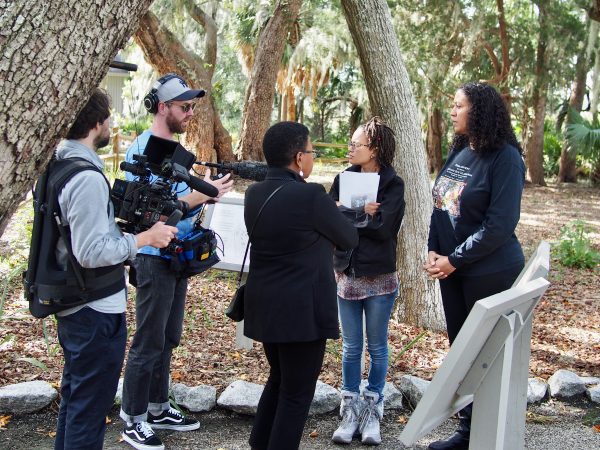
Graveside Ceremony (2020)
John kept in touch with Andrew over the ensuing years. “He would send me copies of pictures, scribbles with some additional information from time to time.”
Arthur Sonny Robinson (1921-2014) passed away in Walterboro, S.C. Deacon Nathan Willie Robinson (1913 – 2018) passed away a couple years ago on St Helena Island.
At the beginning of May, a relative of Andrew Robinson’s contacted the Dataw Historic Foundation. Andrew had just passed away at Harlem Hospital in New York City. She invited John Colgan to speak at Andrew’s graveside ceremony on May 14, 2020 at Eddings Point Cemetery, St. Helena Island. Here are John’s heart-felt remarks.
His family placed a copy of John Colgan’s remarks inside Andrew Robinson’s casket.
Sources
Dataw Historic Foundation, Interviews with Andrew and Willie Robinson, May 2004
Dataw Historic Foundation, Tabby Tattlers, Spring 2008
Good Pitch, A Story of Bones, in production
Lepionka, Larry – Dataw Island, Beaufort County, South Carolina, Cultural Resources Survey, 1988 page 39
Poplin, Eric C. – Recent Archaeological Investigations in the Sams Family Cemetery, Dataw Island, South Carolina, Brockington Cultural Resources Consulting, September 2006
#52Sams Week 22
[print_posts post=”” pdf=”yes” print=”yes” word=”yes”]


